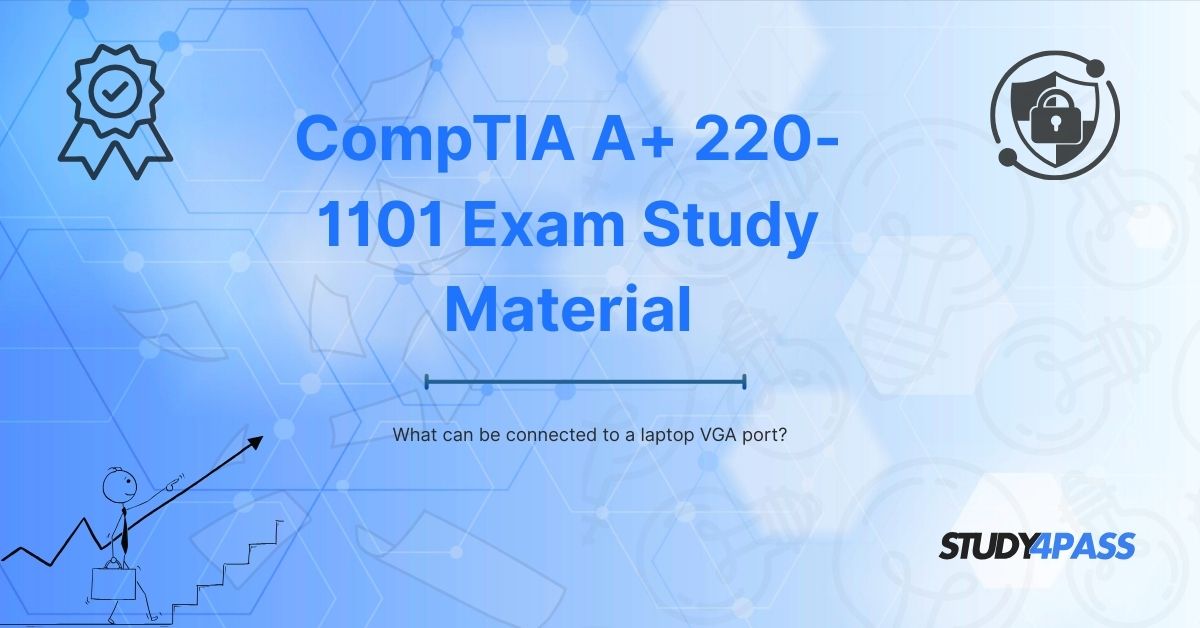Introduction
The Video Graphics Array (VGA) port has been a standard video output interface for decades, commonly found on older laptops, desktops, and monitors. Despite the rise of digital connections like HDMI and DisplayPort, VGA remains relevant in many professional and educational environments.
For those preparing for the CompTIA A+ 220-1101 exam, understanding VGA and its compatibility is essential. This article explores what devices can be connected to a laptop’s VGA port, its advantages and limitations, and alternative solutions. Additionally, we’ll discuss how Study4Pass can help you ace your CompTIA A+ certification with high-quality study materials.
Understanding the VGA Port
The VGA (Video Graphics Array) port is a 15-pin DE-15 connector that transmits analogue video signals. Introduced by IBM in 1987, it was the standard for video output before digital interfaces like HDMI and DisplayPort took over.
Key Features of VGA:
- Analog signal transmission (susceptible to interference)
- Supports resolutions up to 1920×1080 (Full HD) but performs best at lower resolutions
- No audio transmission (requires separate audio cable)
- Gradually being phased out in favour of digital interfaces
Devices That Can Be Connected to a Laptop’s VGA Port
A. External Monitors and Displays
The most common use of a VGA port is to connect a laptop to an external monitor or projector. Many older monitors and business projectors still rely on VGA for compatibility.
Steps to Connect:
- Plug the VGA cable into the laptop’s VGA port.
- Connect the other end to the monitor/projector.
- Power on both devices.
- Press Windows + P (on Windows) or adjust display settings in System Preferences (on macOS with adapters).
B. Projectors for Presentations
Many classroom and office projectors still use VGA. If your laptop has a VGA port, you can directly connect it without needing an adapter.
C. Docking Stations with VGA Support
Some universal docking stations include a VGA port, allowing you to connect multiple peripherals (monitors, keyboards, mice) via a single connection.
D. CRT Monitors (Older Displays)
Older Cathode Ray Tube (CRT) monitors often use VGA. While rare today, they may still be used in specific industrial or legacy systems.
E. VGA to HDMI/DVI/DisplayPort Converters
If your laptop has a VGA port but your monitor only supports HDMI, DVI, or DisplayPort, you can use:
- Active VGA-to-HDMI converter (requires external power)
- Passive VGA-to-DVI-D adapter (for DVI-A/DVI-I ports)
Note: Since VGA is analog and HDMI/DVI-D is digital, an active converter is needed for signal conversion.
Limitations of VGA in Modern Computing
While VGA is versatile, it has several drawbacks:
- Lower image quality compared to digital interfaces (HDMI, DisplayPort)
- No audio support (requires a separate 3.5mm audio cable)
- Signal degradation over long cable distances
- Being phased out in newer laptops and monitors
Alternatives to VGA for Modern Laptops
Since many modern laptops no longer include VGA, users often rely on adapters or alternative ports:
|
Port Type |
Advantages |
Disadvantages |
|
HDMI |
Supports audio & video, high resolutions |
Limited cable length without boosters |
|
DisplayPort |
High refresh rates, daisy-chaining |
Less common on budget devices |
|
USB-C (with Alt Mode) |
Supports video, power, and data |
Requires compatible hardware |
|
DVI |
Digital signal (DVI-D), good for monitors |
No audio, bulky connector |
How This Knowledge Helps in CompTIA A+ 220-1101 Exam?
The CompTIA A+ 220-1101 exam covers hardware and networking fundamentals, including display interfaces like VGA. Understanding:
- Legacy vs. modern video ports
- Adapter requirements
- Troubleshooting display issues
…will help you answer related questions confidently.
Why Choose Study4Pass for CompTIA A+ Preparation?
If you're preparing for the CompTIA A+ 220-1101 exam, Study4Pass offers:
Comprehensive Study Guides – Detailed explanations of exam objectives.
Practice Tests – Simulate real exam conditions with timed quizzes.
Video Tutorials – Visual learning for complex topics.
Up-to-Date Content – Aligned with the latest exam syllabus.
Exam Tips & Tricks – Strategies to maximize your score.
Visit Study4Pass today and boost your certification journey!
Conclusion
While VGA is an older technology, it remains useful for connecting laptops to monitors, projectors, and legacy displays. For CompTIA A+ 220-1101 candidates, mastering these concepts ensures success in hardware-related exam questions.
For the best exam preparation, leverage Study4Pass expert resources to gain a competitive edge. Start studying now and achieve your A+ certification with confidence!
Special Discount: Offer Valid For Limited Time “CompTIA A+ 220-1101 Study Material”
Actual Exam Questions For CompTIA's A+ 220-1101 Test Preparation
Sample Questions For CompTIA A+ 220-1101 Test
Here are 5 multiple-choice questions (MCQs) based on the question "What can be connected to a laptop VGA port?":
1. What can be connected to a laptop VGA port?
A) External hard drive
B) Printer
C) Monitor
D) Keyboard
2. Which of the following devices typically uses a laptop VGA port for connection?
A) Speakers
B) Projector
C) Webcam
D) USB drive
3. What type of device is most commonly connected to a laptop using a VGA port?
A) External speakers
B) External display (monitor or projector)
C) External storage devices
D) Mouse
4. Which of these is NOT typically connected to a laptop via the VGA port?
A) Monitor
B) Television
C) External keyboard
D) Projector
5. A laptop VGA port is primarily used to connect:
A) Mouse and keyboard
B) Display devices like monitors or projectors
C) Network cables
D) USB peripherals


